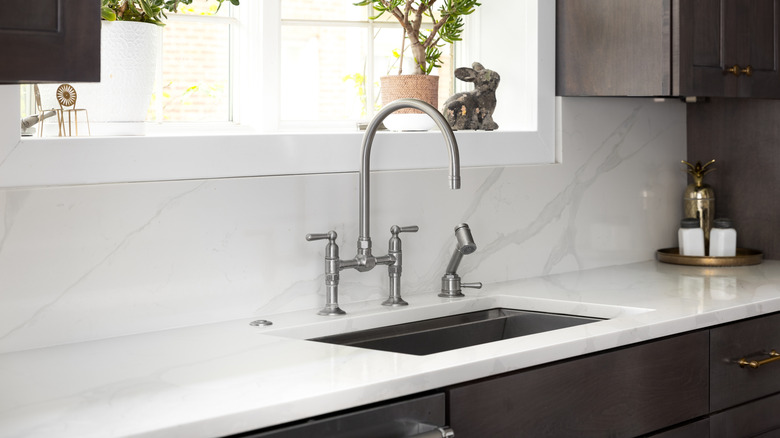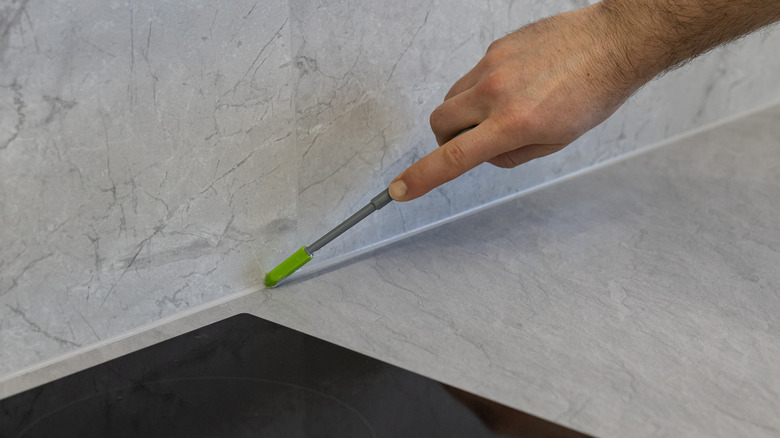Is A Silicone Countertop Protector Worth The Purchase Or A Hoax?
We may receive a commission on purchases made from links.
There are many important things to consider when you want your dream kitchen to become a reality. Designing the perfect layout. Picking out the right countertop material. Choosing the ideal appliances. From opting for outdated finishes to blowing through your budget, there are a lot of common kitchen renovation mistakes that are all-too-easy to make, especially if you DIY. But according to Carmine Argano, Owner of a kitchen remodeling company in Long Island, one of the worst things you can do is forget to use silicone sealant on your kitchen countertops after installing them, because it not only provides a clean and finished look, but also protects wooden cabinets and other moisture-prone areas from damage.
"I recommend silicone sealant for all kitchen countertop installations, especially around sinks and backsplashes," Argano told House Digest during an exclusive interview. "It protects the underlying materials, especially wood-based cabinets or MDF substrates, from moisture damage, which is one of the biggest long-term threats in any kitchen." The remodeling expert said it's a frequently skipped step, but that a simple bead of silicone sealant, like the DAP 100% Silicone Rubber Sealant, will extend the life of your countertops. "It's inexpensive, easy to apply, and incredibly effective at blocking water intrusion," Argano explained. The kitchen remodeling expert recommended spending a little more on a high-quality product once you've decided you're going to use silicone to protect your countertops. "A $10 tube of the good stuff will outperform a $3 tube every time."
The pros and cons of using silicone sealant
"Silicone sealant is a waterproof, flexible adhesive commonly used to seal joints, gaps, and seams around sinks, countertops, backsplashes, and other kitchen surfaces," Carmine Argano told House Digest during his exclusive interview. Because water, grease, and food are prone to seeping into the cracks between your countertop and sink, or backsplash and walls, Argano explained that silicone sealant is typically used where two different materials meet. "What makes silicone unique is that it stays flexible even after it cures. It moves with the material, so if your countertop expands or contracts slightly (due to temperature or humidity), the sealant doesn't crack," he said. The kitchen remodeling expert added that silicone sealants are also heat and mold resistant.
Picking out a durable kitchen countertop material is important if you want your investment to stand the test of time, and Argano said silicone sealant "bonds extremely well to non-porous materials like quartz, granite, stainless steel, and laminate." He prefers it over acrylic caulk or latex-based sealants because it protects better against water and humidity. "A good-quality silicone sealant can last 10-plus years without needing replacement," Argano said. But there are some disadvantages to silicone sealant you should keep in mind before applying it to your countertops. "It's harder to clean than other types of caulk," he mentioned. "You can't just wipe it off and you'll need mineral spirits or a silicone remover." It also can't be painted over, which can be a cause for concern if you're sealing near a painted surface. "That said, for kitchens and bathrooms, the pros outweigh the cons every time," Argano noted.
Take safety precautions before applying silicone sealant to your countertops
Silicone sealant is absolutely worth it if you want to protect your countertops, but there is some important safety information you need to keep in mind before applying it in your kitchen. "Standard silicone sealant is not food-safe, so you should not use it directly on surfaces where food is prepared, like cutting boards or butcher block tops," Carmine Argano emphasized during his exclusive interview with House Digest. "That said, when used as intended in seams and gaps there's no safety risk." The kitchen remodeling expert said if you're still concerned about putting your family's health at risk, you should look for non-toxic sealants labeled as "NSF-certified" or "food zone safe," which are commonly used in commercial kitchens and breweries, like the Silco RTV 4500 Food-Grade Silicone.
Once you've picked the right silicone sealant for your space, the final step is applying it. Argano recommends using painter's tape to mask off both sides of your seam before getting started. "This gives you a perfect, clean bed with zero mess," he explained. Next, he said to cut the nozzle at a 45 degree angle before using consistent pressure to create a smooth bead of silicone along the joint. "Tool it immediately," Argano recommended. "Use a caulk finishing tool or even a wet finger to smooth the bead before it skins over (which usually happens in five to 10 minutes)." Lastly, make sure you complete the process in a well ventilated space. "Silicone gives off fumes while curing," he said. "Keep the area well-ventilated for at least a few hours."


